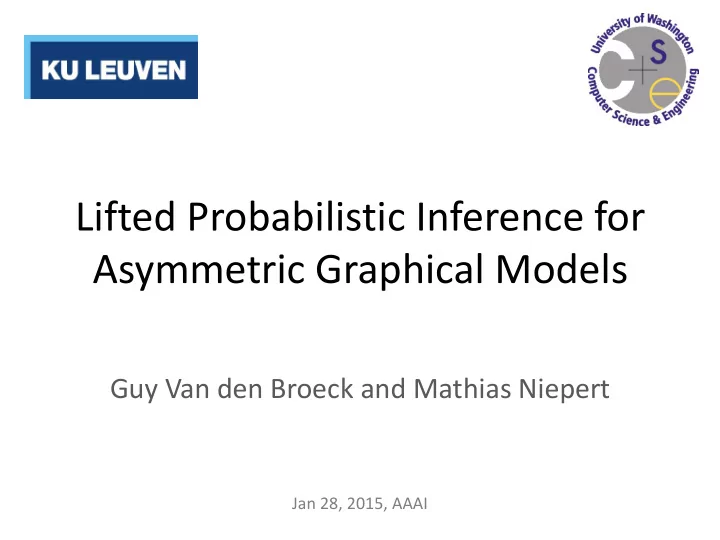

Lifted Probabilistic Inference for Asymmetric Graphical Models Guy Van den Broeck and Mathias Niepert Jan 28, 2015, AAAI
Take-Away Message Two problems: 1. Lifted inference gives exponential speedups in symmetric graphical models. But what about real-world asymmetric problems? 2. When there are many variables , MCMC is slow . How to sample quickly in large graphical models? One solution: Exploit approximate symmetries !
Approximate Symmetries • Symmetry g: Pr( x ) = Pr( x g ) E.g. Ising model without external field 0 0 1 1 0 1 1 0 Pr = Pr 1 0 1 0 1 1 0 0 1 1 1 1 0 1 1 1 0 1 0 0 0 1 0 1 • Approximate symmetry g: Pr( x ) ≈ Pr( x g ) E.g. Ising model with external field
Orbital Metropolis Chain: Algorithm • Given symmetry group G (approx. symmetries) • Orbit x G contains all states approx. symm. to x • In state x : 1. Select y uniformly at random from x G Pr 𝒛 Pr 𝒚 , 1 2. Move from x to y with probability min 3. Otherwise: stay in x (reject) 4. Repeat
Orbital Metropolis Chain: Analysis Pr(.) is stationary distribution Many variables change (fast mixing) Few rejected samples: Pr 𝒛 ≈ Pr 𝒚 ⇒ min Pr 𝒛 Pr 𝒚 , 1 ≈ 1 Is this the perfect proposal distribution?
Orbital Metropolis Chain: Analysis Pr(.) is stationary distribution Many variables change (fast mixing) Few rejected samples: Pr 𝒛 ≈ Pr 𝒚 ⇒ min Pr 𝒛 Pr 𝒚 , 1 ≈ 1 Is this the perfect proposal distribution? Not irreducible… Can never reach 0100 from 1101.
Lifted Metropolis-Hastings: Algorithm • Given an orbital Metropolis chain M S for Pr(.) • Given a base Markov chain M B that – is irreducible and aperiodic – has stationary distribution Pr(.) (e.g., Gibbs chain or MC-SAT chain) • In state x : 1. With probability α , apply the kernel of M B 2. Otherwise apply the kernel of M S
Lifted Metropolis-Hastings: Analysis Theorem [Tierney 1994]: A mixture of Markov chains is irreducible and aperiodic if at least one of the chains is irreducible and aperiodic . Pr(.) is stationary distribution Many variables change (fast mixing) Few rejected samples Irreducible Aperiodic
Gibbs Sampling Lifted Metropolis- Hastings G = (X 1 X 2 )(X 3 X 4 )
Example: Grid Models KL Divergence
Example: Statistical Relational Model • WebKB: Classify pages given links and words • Very large Markov logic network and 5000 more … • No symmetries with evidence on Link or Word • Where do approx. symmetries come from?
Over-Symmetric Approximations • OSA makes model more symmetric • E.g., low-rank Boolean matrix factorization Link ( “aaai.org” , “google.com” ) Link ( “aaai.org” , “google.com” ) Link ( “google.com” , “ aaai.org ” ) Link ( “google.com” , “aaai.org” ) Link ( “google.com” , “gmail.com” ) - Link ( “google.com” , “gmail.com” ) Link ( “ibm.com” , “aaai.org” ) + Link ( “aaai.org” , “ibm.com” ) Link ( “ibm.com” , “aaai.org” ) google.com and ibm.com become symmetric! [Van den Broeck & Darwiche ‘13], [ Venugopal and Gogate ‘14], [ Singla, Nath and Domingos ‘14]
Experiments: WebKB
Experiments: WebKB
Conclusions • Lifted Metropolis Hastings – works on any graphical model – exploits approximate symmetries – does not require any exact symmetries – converges to the true marginals – mixes faster (changes many variables per iteration) – has low rejection rate • Practical lifted inference algorithm • Need more research on over-symmetric approximations!
Thank you
Recommend
More recommend